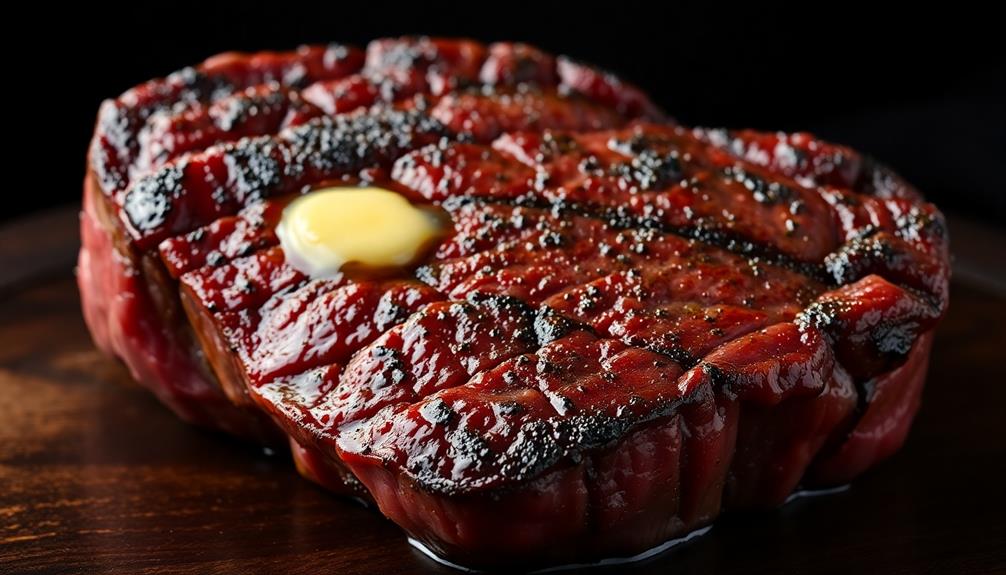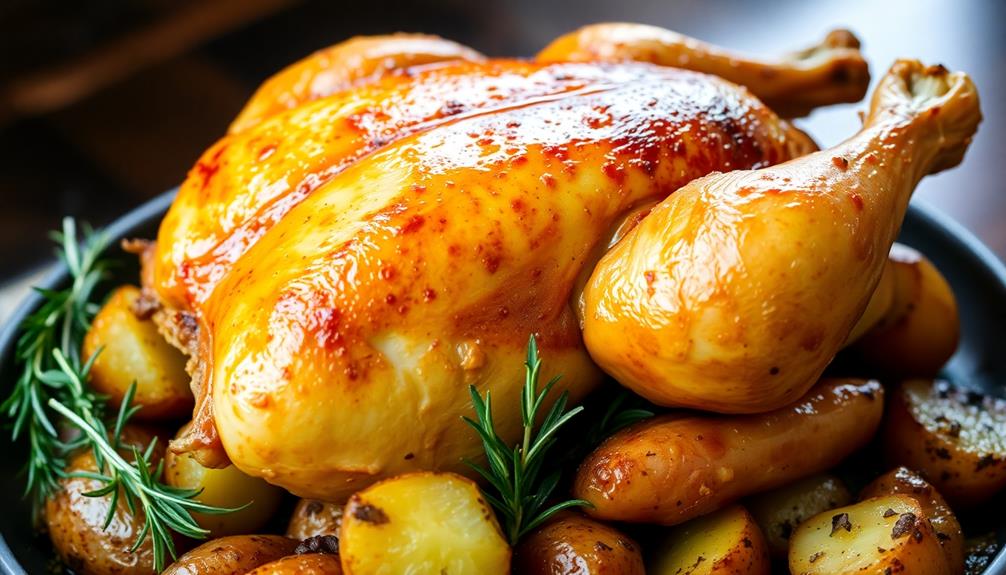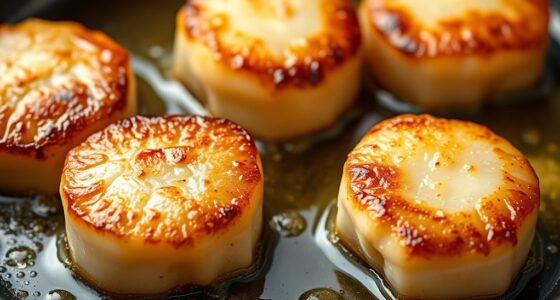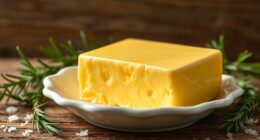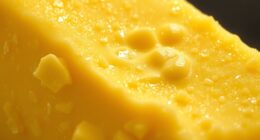You'll be amazed at how juicy and flavor-packed a steak can be when you use the butter-basting technique on a well-marbled ribeye. This time-honored method, favored by steakhouses worldwide, infuses the beef with a rich, buttery essence that simply melts in your mouth, creating an unforgettable dining experience you'll want to recreate again and again. The golden-brown exterior gives way to a tender, succulent interior, the aroma of sizzling butter and beef captivating your senses. With just a few simple steps, you can elevate your steak game and discover the juiciest, most flavorful steak you've ever tasted. Keep reading to uncover the secrets behind this culinary masterpiece.
Key Takeaways
- The butter-basting technique results in a golden-brown exterior and tender, succulent interior, elevating the ribeye steak's status as a culinary masterpiece.
- Searing the steak is crucial for flavor development and caramelization, while the butter basting during cooking enriches the taste and retains the natural juices.
- Precise timing in achieving the optimal doneness, aiming for medium-rare, ensures a perfect balance of tenderness and juiciness.
- The rich, savory butter adds depth to the meat, creating a velvety, umami delight with each bite.
- This flavorful combination makes the dish a favorite among steak lovers, often resulting in cravings after the first experience.
History
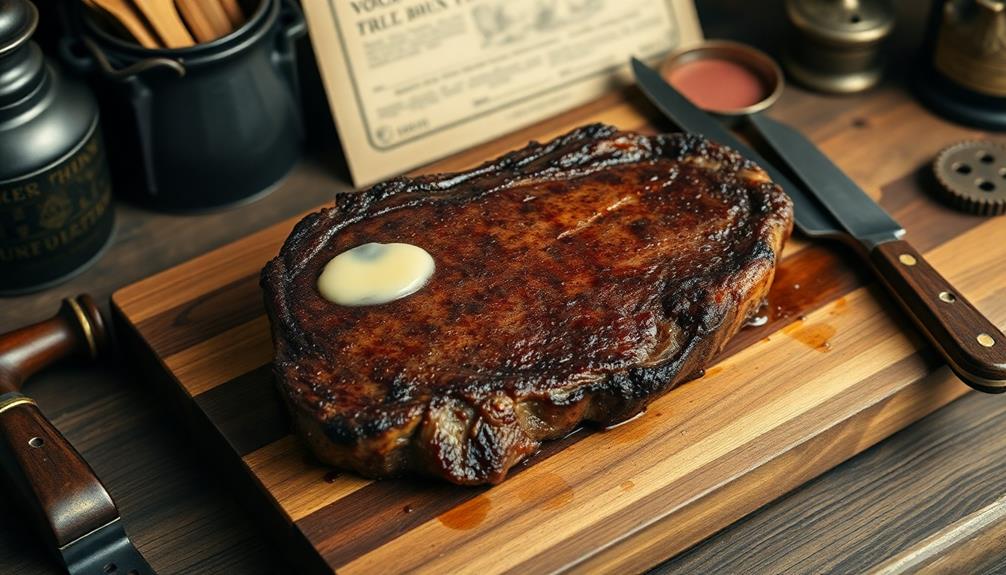
Although the origins of the butter-basted ribeye steak are somewhat obscure, it's believed this cooking method has been employed for centuries. Generations of skilled chefs and passionate home cooks have perfected the art of searing a thick, juicy ribeye steak to perfection, then basting it with rich, creamy butter.
This simple yet indulgent technique has stood the test of time, resulting in a steak that's golden-brown on the outside, tender and succulent on the inside.
The alluring aroma of sizzling butter and perfectly-cooked beef has captivated diners for ages. Imagine the first time someone drizzled melted butter over a hot steak – the way it sizzles and clings to the meat, infusing it with unparalleled flavor and a luxurious mouthfeel.
This time-honored method has become a hallmark of steakhouse cuisine, elevating the humble ribeye to new heights of deliciousness. Whether you're a seasoned grill master or a novice cook, mastering the butter-basted ribeye is a culinary milestone worth celebrating.
Recipe

Cooking a perfectly seared and butter-basted ribeye steak at home is a simple yet impressive feat. The key to achieving a restaurant-quality steak lies in the technique of basting the meat with butter as it cooks, which helps to create a golden-brown crust and infuses the steak with rich, decadent flavor.
Butter's creamy texture and ability to enhance the flavor of dishes make it a favorite among chefs butter enhances flavor.
To begin, it's essential to start with a high-quality, well-marbled ribeye steak at room temperature. This allows the meat to cook evenly and helps to prevent the formation of a grey, overcooked exterior while the center remains rare or medium-rare.
Ingredients:
- 1 (1-inch thick) ribeye steak, at room temperature
- 2 tablespoons unsalted butter
- 1 tablespoon vegetable oil
- Kosher salt and freshly ground black pepper
Cooking Instructions:
Preheat a cast-iron or heavy-bottomed skillet over high heat.
Pat the steak dry with paper towels and generously season it with salt and pepper on all sides.
Add the vegetable oil to the hot pan and carefully place the steak in the center.
Sear the steak for 2-3 minutes per side, or until a deep, golden-brown crust forms.
Reduce the heat to medium-low, and add the butter to the pan.
Tilt the pan and use a spoon to continuously baste the steak with the melted butter for 2-3 minutes.
Flip the steak and repeat the basting process on the other side for an additional 2-3 minutes.
Use a meat thermometer to check the internal temperature, which should reach 125°F for medium-rare.
To ensure the perfect steak, allow the meat to rest for 5-10 minutes before slicing into it.
This resting period allows the juices to redistribute throughout the steak, resulting in a tender, flavorful, and juicy final product.
Cooking Steps
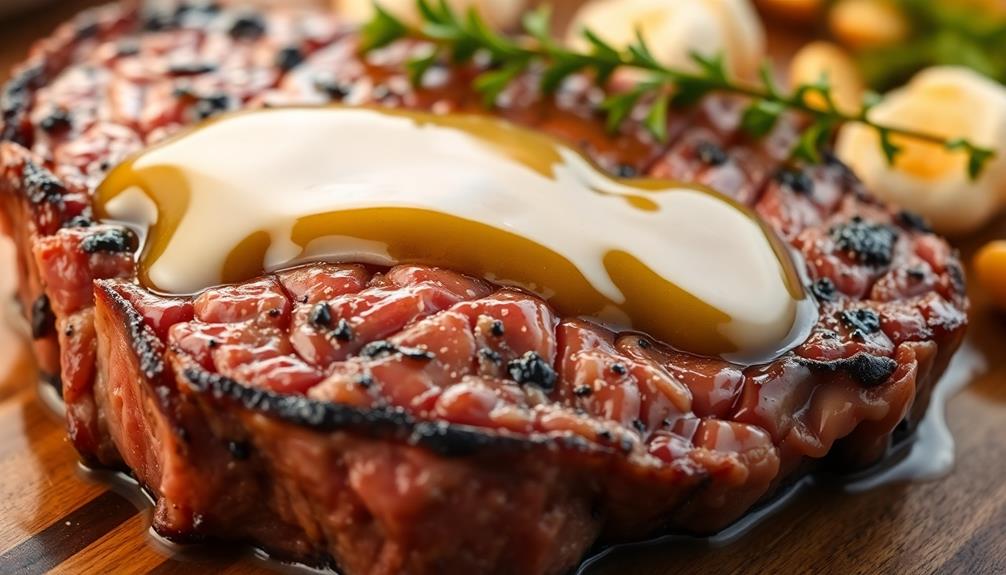
Preheat your oven to a sizzling temperature.
Pat the steak dry with paper towels to ensure a perfect sear.
Sear the steak in a hot cast-iron skillet, then baste it with melted butter before transferring it to the oven.
Step 1. Preheat Oven to Sizzling Temperature
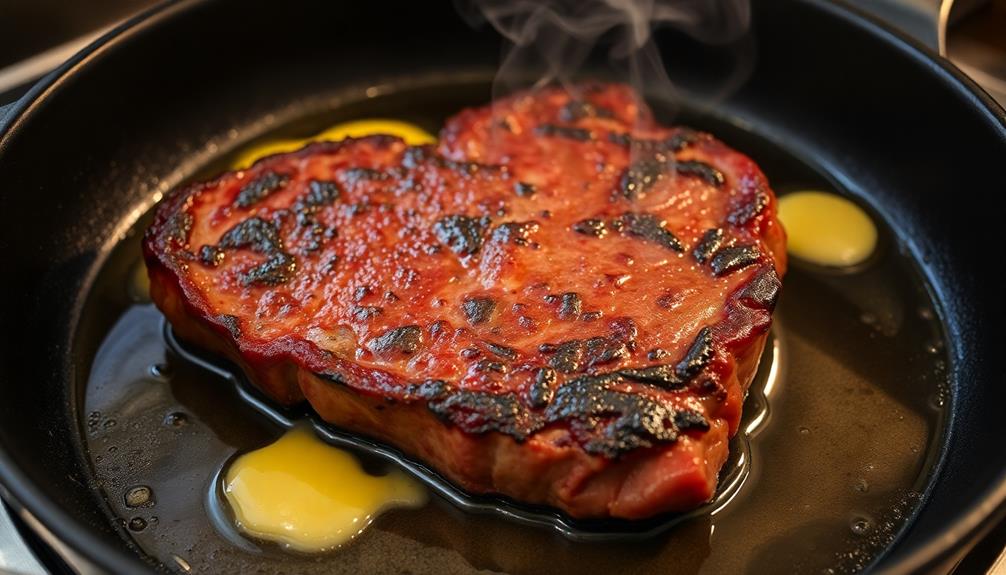
Preheat your oven to a scorching 500°F (260°C). You want that oven rarin' to go – a blazing hot temperature that'll sear the outside of your ribeye steak to perfection.
As the oven preheats, you can start prepping your steak. Pat it dry with paper towels, then generously season both sides with salt and pepper. This step is crucial, as it'll amp up the natural beefy flavors.
Once your oven is piping hot, carefully transfer the seasoned steak to a heavy-duty oven-safe skillet or cast-iron pan. You want that steak to sizzle the moment it hits the pan!
Sear it for 2-3 minutes per side, basting constantly with melted butter. This rapid high-heat cooking will create a delectable crusty exterior, sealing in all those juices.
After searing, pop the pan straight into the oven. Roast the steak until it reaches your desired doneness, basting occasionally for maximum flavor and tenderness.
Get ready for a steak experience that'll blow your mind!
Step 2. Pat Steak Dry With Paper Towels
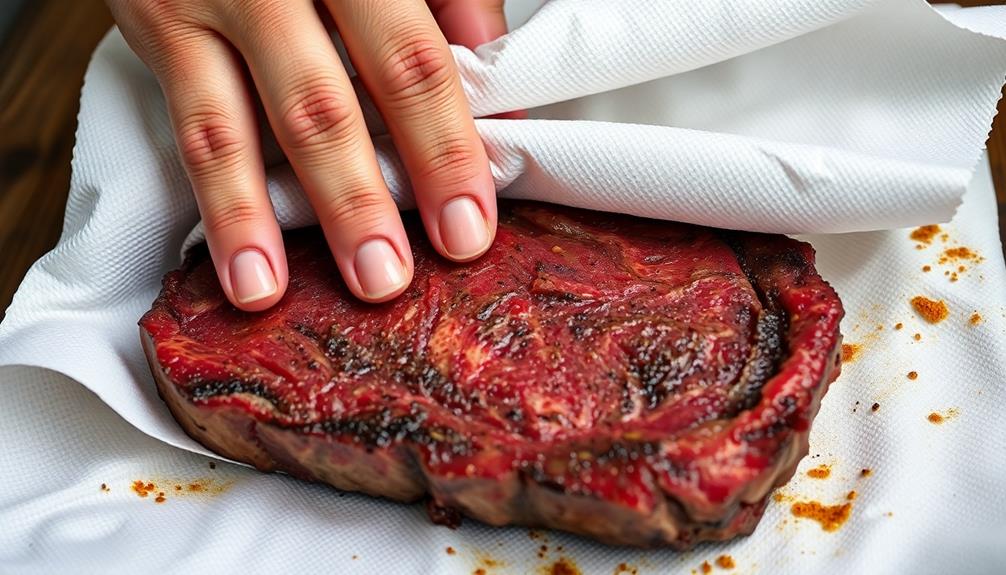
Thorough drying is the first step to searing perfection. Grab a stack of paper towels and gently blot the surface of your ribeye steak.
Don't rub or press too hard – you want to remove excess moisture without compromising the meat's texture. As you dab, you'll see tiny beads of water appear on the towels, signaling successful moisture removal.
Ensuring the steak is thoroughly patted dry is crucial. Any lingering moisture will prevent the exterior from browning and crisping up properly during the sear.
You want that beautiful, caramelized crust that seals in the steak's natural juices. So take your time and be meticulous. Run the towels over every nook and cranny until the surface looks and feels completely dry.
With this simple prep, you're one step closer to a mouthwatering, butter-basted ribeye that will have your taste buds singing.
Step 3. Sear Steak in Hot Cast-Iron Skillet

With the steak thoroughly dried, it's time to sear it to perfection in a blazing hot cast-iron skillet. Crank up the heat to high and let that pan get ripping hot. You want it so hot that a drop of water will instantly sizzle and evaporate.
Carefully place the steak in the center of the pan and let it sear, undisturbed, for 2-3 minutes. Resist the urge to peek or move it around – you want that beautiful crust to form.
Now, use tongs to flip the steak and sear the other side for another 2-3 minutes. You'll know it's ready when you see a rich, caramelized crust developing.
Keep an eye on the edges, too, and sear those as well for even browning all around. The cast-iron will retain heat beautifully, ensuring an amazing sear on your steak.
Get ready for the most mouth-watering, flavor-packed bite you've ever had!
Step 4. Baste Steak With Melted Butter
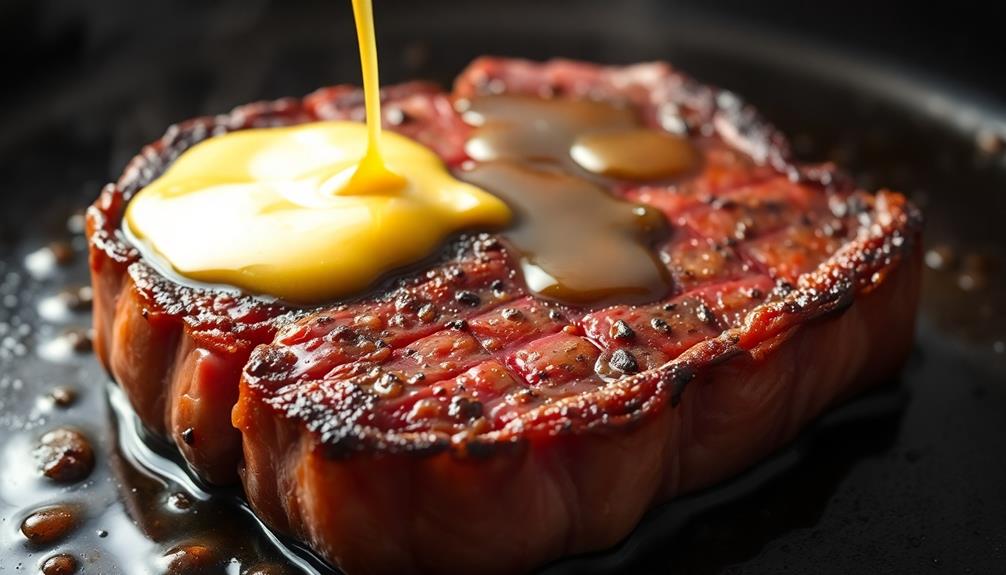
Once the steak has developed that gorgeous sear, it's time to baste it with some melted butter.
Grab your trusty cast-iron skillet and the remaining butter from the initial searing process. Gently tilt the skillet and use a large spoon to continuously scoop and pour the warm, golden butter over the top of the steak. This basting technique will create a rich, velvety texture and a mouthwatering aroma that will have your taste buds dancing.
As the butter coats the steak, you'll notice it start to foam and sizzle. This is exactly what you want – the butter is caramelizing and infusing the meat with its irresistible flavor.
Keep basting for 1-2 minutes, making sure to cover every inch of the steak. The butter will create a shiny, glistening crust that locks in the juices and amplifies the beefy goodness.
Get ready for the most decadent, butter-basted steak you've ever experienced!
Step 5. Transfer to Oven
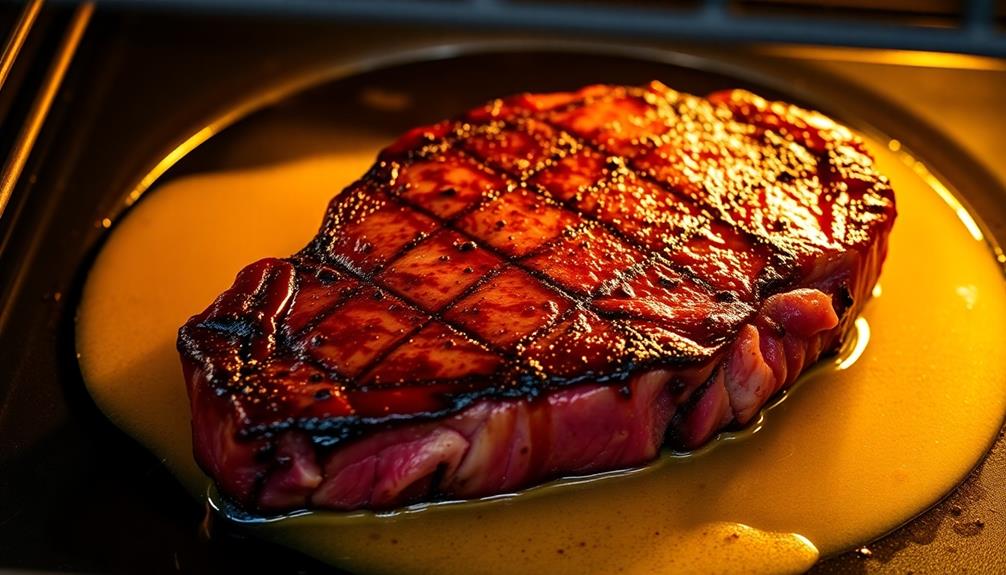
After basting the steak with the melted butter, transfer it to a preheated oven.
You'll want to make sure your oven is nice and hot, around 450°F (230°C). Carefully place the steak on a rimmed baking sheet or in a cast-iron skillet. The high heat of the oven will help create a gorgeous, caramelized crust on the outside of the steak while the interior stays juicy and tender.
As the steak cooks, resist the temptation to open the oven door and peek. This will let out valuable heat and can affect the cooking time. Instead, set a timer and let the oven do its magic.
Depending on the thickness of your steak, it should take 10-15 minutes to reach your desired level of doneness. Use a meat thermometer to check the internal temperature – pull it out when it reaches 125°F (52°C) for a perfect medium-rare.
Let the steak rest for 5-10 minutes before slicing into it and enjoying every bite of this decadent, butter-basted ribeye.
Final Thoughts

When it comes to the butter-basted ribeye steak, you'll find that the final result is simply sublime. The combination of the tender, juicy meat and the rich, savory butter creates a flavor profile that's out of this world.
As you take that first bite, you'll be captivated by the way the butter melts in your mouth, coating your taste buds with a velvety, umami delight.
The searing process has caramelized the exterior, locking in the natural juices and imparting a delightful crunch that contrasts beautifully with the soft, tender interior.
You'll find yourself savoring every morsel, unable to resist the temptation to lick your fingers clean. The steak is so flavorful and satisfying that you might just find yourself reaching for seconds, unable to get enough of this culinary masterpiece.
Truly, the butter-basted ribeye steak is a dish that will leave an indelible mark on your memory, and one that you'll crave time and time again.
Frequently Asked Questions
How Do I Select the Best Ribeye Steak?
When selecting a ribeye steak, look for a well-marbled cut with a bright, red color. Avoid steaks that are pale or have excessive fat. You'll get the most flavor and tenderness by choosing a USDA Choice or Prime grade.
What's the Ideal Thickness for a Ribeye Steak?
The ideal thickness for a ribeye steak is typically between 1 to 1.5 inches. This thickness allows the steak to cook evenly and ensures you'll get a juicy, tender bite. The thicker the steak, the longer it'll take to cook through.
Can I Substitute Regular Butter for Flavored Butter?
You can certainly substitute regular butter for flavored butter, but you'll miss out on the added flavor the flavored butter would provide. The regular butter will still baste the steak, but it won't have the same depth of taste.
How Do I Store Leftover Cooked Ribeye Steak?
To store leftover cooked ribeye steak, place it in an airtight container or resealable bag in the refrigerator. It'll keep for 3-4 days. When ready to reheat, use gentle heat to avoid drying out the meat.
Is It Possible to Make This Recipe in the Oven?
You can absolutely make this recipe in the oven. Simply sear the steak on the stovetop, then finish it in the oven until it reaches your desired doneness. This method will give you a juicy, flavorful steak without the need for a grill.
